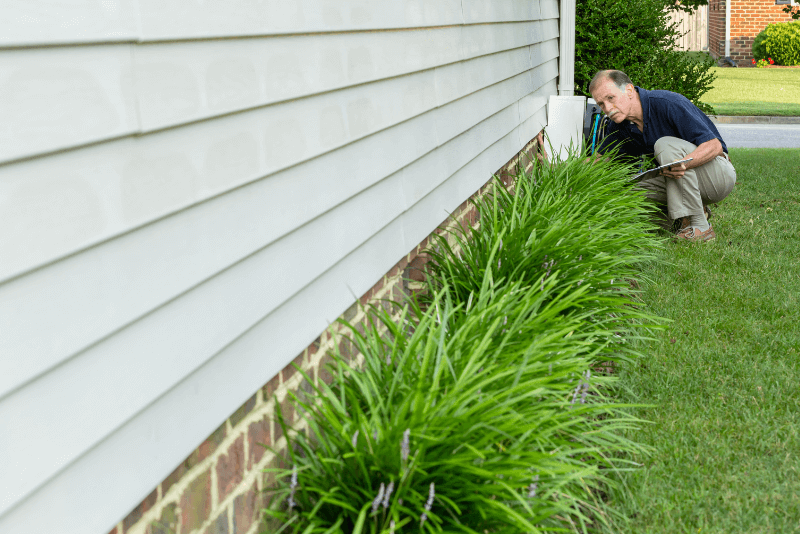
Selling your home can be stressful, and discovering visible foundation cracks can add to this stress. Worrying that these cracks might deter potential buyers or lower your home’s value is natural.
Cracks are common in concrete foundations, but many can be fixed with DIY methods. Addressing cracks in your home’s foundation can be crucial for a successful sale.
In this guide, we’ll cover everything you need to know about how to fix foundation cracks by yourself. From identifying the source of the cracks to the final touches of repair, we’ll outline the steps to ensure your home is in top condition.
Fixing Foundation Cracks By Yourself
Many homeowners face foundation cracks, and while they can appear alarming, you can often effectively tackle many of these repairs yourself. DIY foundation repair is often a useful solution for owners of older homes, including inherited property.
Addressing foundation cracks is crucial for maintaining your home’s structural stability. Repairing these cracks not only prevents future damage but also ensures the safety and longevity of your property. It’s a proactive step in preserving your house’s overall health.
Separately, repairing foundation cracks significantly enhances the aesthetic appeal of your home. It’s one of the most essential tips to stage your house in Fort Worth. A well-maintained foundation gives potential buyers confidence and can make your home stand out in the market.
You don’t need extensive home repair experience to fix common types of foundation cracks. The process is straightforward and can be accomplished with some patience and careful attention to detail.
You can also skip repairs entirely and sell your home as-is to a professional home-buying company such as Four 19 Properties. You might recognize them from their “We buy houses in Houston” signs found throughout the area.
How to Fix Foundation Cracks By Yourself
Fixing foundation cracks by yourself is a process that involves nine distinct steps. Each step requires precision and attention to detail, ensuring a successful DIY repair.
Find the Source of the Crack
The first step is identifying where and why your foundation is cracking. Often, cracks result from natural settling, but they can also indicate more serious issues. Inspect the area thoroughly, both inside and outside your home. Look for patterns that suggest the underlying cause, such as water damage or soil shifting.
Pay special attention to basement walls, as cracks in concrete surfaces here are common and often overlooked. Examine your foundation wall closely for signs of horizontal cracks, which could indicate more serious structural issues. Inspect your concrete wall for any signs of concrete cracks, as these are common in older homes. Remember to check the crawl space, too, as cracks here often go unnoticed.
Understanding the cause is crucial before proceeding with repairs. Professional advice might be necessary if the cracks are due to severe structural problems, while DIY repair is feasible for simpler causes like minor settling or seasonal changes.
Rectify the Source of the Damage
Once you identify the cause of the foundation issues, the next step is addressing it to prevent further damage. If water is the culprit, ensure proper drainage around your foundation. Solutions could involve cleaning gutters, installing downspout extensions, or adjusting the landscape to divert water from your home.
If the soil is shifting, consider soil stabilization techniques. You might also need to adjust the soil’s moisture level around your home. Consistent soil moisture helps prevent expansion and contraction, which can cause foundation movement.
Addressing foundation cracks typically involves waterproofing to prevent future water damage. Basement waterproofing is essential for protecting your home’s basement wall and foundation.
Repair a Foundation Crack With an Epoxy Sealer
An epoxy sealer is an effective method for repairing foundation cracks. This sealer adheres well to concrete, providing a robust and durable repair. Begin by using a wire brush to clean the crack thoroughly. Remove any loose material and debris to ensure the epoxy bonds properly to the concrete.
Once cleaned, prepare the epoxy filler as per the manufacturer’s instructions. Apply the sealer carefully into the crack, ensuring it penetrates deeply. The seal not only repairs the crack but also helps prevent future water ingress.
For hairline cracks, a simple caulk designed for concrete can be an effective temporary solution. When repairing cracks in areas subject to movement, a polyurethane sealant might be a more suitable choice than epoxy.
Block Out Injection Ports
The next step involves preparing for the epoxy injection. This is done by attaching injection ports along the crack. Start by spacing the ports evenly along the crack, typically about eight to 12 inches apart. Ensure the ports are firmly attached to the foundation surface.
Blocking out these ports is essential for a controlled repair process. It allows you to inject the epoxy precisely into the crack, ensuring its entire depth is filled, providing a more effective and longer-lasting repair.
Using a caulking gun with concrete caulk can be an effective solution for smaller cracks.
Add in Injection Ports
After setting up the ports, it’s time to install them properly. Insert each injection port into the holes you’ve created along the crack. Make sure they are securely in place. These ports are crucial for the next steps, as they guide the epoxy directly into the crack.
Correct port installation ensures an even distribution of epoxy, which is essential for a thorough seal. Without proper installation, the epoxy might not reach the entire crack depth, compromising the repair.
Spread Sealer Along the Crack
Once the ports are in place, apply a sealer over the entire length of the crack. This sealer, unlike the injected epoxy, acts as a surface sealant. It should be applied smoothly, covering the crack and the base of the injection ports.
The surface sealer plays a vital role. It prevents the epoxy from leaking out during the injection process. A good seal ensures the epoxy cures inside the crack, creating a solid bond reinforcing the foundation.
Inject Epoxy Into Crack
Now, it’s time to inject the epoxy. Start at the lowest port and slowly fill it until the epoxy reaches the next port. This process requires patience and a steady hand. The goal is to fill the wall crack entirely from bottom to top.
Continue this process, moving upwards from port to port. As you inject the epoxy, it should flow upwards, filling the crack. Aim for thorough penetration of the sealer, which maximizes the repair’s durability.
Seal Injection Ports
After injecting the epoxy, the next step is to seal the ports and contain the epoxy within the crack as it cures. Use a suitable cap or sealer to close each port, and ensure that each cap is secure and tight.
Sealing the ports helps maintain the internal pressure of the injected epoxy. The pressure is necessary for the epoxy to bond properly with the concrete. A good seal ensures a consistent cure throughout the crack, leading to a stronger repair.
Remove Injection Ports
The final step is to remove the injection ports once the epoxy has fully cured. Depending on the product and environmental conditions, you might need to wait several days. Check the manufacturer’s guidelines for the specific curing time.
Carefully remove each port. You can gently use a hammer and chisel to break them off at the base. Depending on the desired finish, the remaining surface sealer can also be removed or smoothed over.

Is It Safe to Repair Foundation Cracks By Yourself?
If you’re dealing with a cracked foundation, it’s important to assess the safety of undertaking the repair yourself. While DIY foundation crack repairs are generally safe, it’s crucial to keep some important tips in mind to ensure a successful and hazard-free repair process.
- Wear Protective Gear: Always wear safety glasses, gloves, and a dust mask when working on foundation repairs. These protect you from concrete dust, chemical exposure from sealants, and any debris.
- Proper Ventilation: When using chemical sealants or epoxy, ensure your work area is well-ventilated. You want to avoid inhaling any fumes, which can be harmful in enclosed spaces.
- Follow Instructions Carefully: Always read and follow the manufacturer’s instructions for any repair materials you use. This ensures not only the effectiveness of the repair but also your safety during its application.
- Check Structural Integrity: For small cracks and non-structural cracks, DIY repair is typically safe and effective. However, large cracks might require a professional assessment to ensure the home’s safety. Be particularly cautious with horizontal cracks; they typically warrant a professional’s assessment.
- Avoid Electrical and Plumbing Lines: Be cautious of electrical wiring and plumbing lines. Accidentally damaging these can lead to more severe problems and potentially dangerous situations.
When dealing with hairline cracks, proceeding with DIY repairs is usually safe, but always follow safety guidelines. However, large or multiple cracks might indicate more severe foundation problems.
If you’re unsure about the severity of the crack or the repair process, it’s wise to consult a professional, such as a home contractor or structural engineer. Sometimes, what seems minor can indicate a more serious underlying issue.
Conclusion
Addressing a concrete crack in your foundation is usually a worthwhile home improvement project. While learning how to fix foundation cracks by yourself can seem daunting, with the right approach, it can be a straightforward DIY project that adds significant value to your home.
Repairs are particularly vital if you’re preparing to sell your property, as a damage-free foundation not only improves the structural integrity and appearance of your home but also boosts its market appeal.
If you want to sell your home quickly, even if it needs foundation crack repair, contact the professional home-buying company Four 19 Properties. We buy houses in Fort Worth as-is, even if they’re damaged or in poor condition. Selling your home to Four 19 Properties is an easy way to avoid costly repairs and get cash in hand fast.
